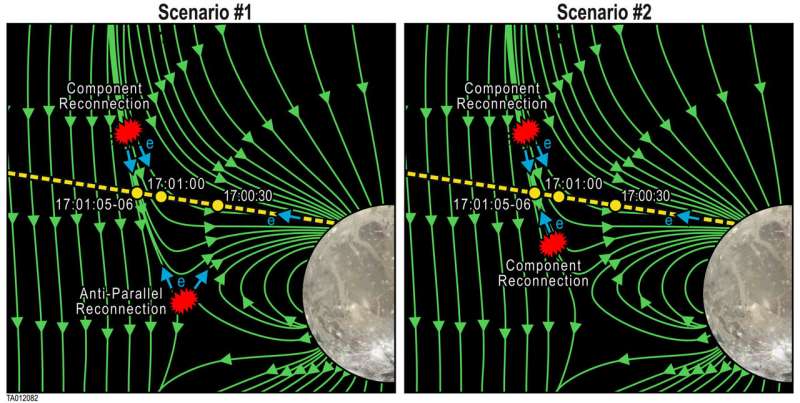Scientists find evidence for magnetic reconnection between Ganymede and Jupiter
JANUARY 10, 2023
by Southwest Research Institute

Interpretation of magnetic topology and electron flow direction for two different reconnection scenarios at Ganymede's upstream magnetopause. The Y–Z projection of the magnetic field line configuration is adapted from Jia et al. (2008). Yellow dashed line indicates Juno's trajectory. Credit: Geophysical Research Letters (2022). DOI: 10.1029/2022GL099775
In June 2021, NASA's Juno spacecraft flew close to Ganymede, Jupiter's largest moon, observing evidence of magnetic reconnection. A team led by Southwest Research Institute used Juno data to examine the electron and ion particles and magnetic fields as the magnetic field lines of Jupiter and Ganymede merged, snapped and reoriented, heating and accelerating the charged particles in the region.
"Ganymede is the only moon in our solar system with its own magnetic field," said Juno Principal Investigator Dr. Scott Bolton of SwRI. "The snapping and reconnecting of Ganymede's magnetic field lines with Jupiter's creates the magnetospheric fireworks."
Magnetic reconnection is an explosive physical process that converts stored magnetic energy into kinetic energy and heat. Ganymede's mini-magnetosphere interacts with Jupiter's massive magnetosphere, in the magnetopause, the boundary between the two regions.
"We interpreted the presence of accelerated electrons traveling along the magnetic field at Ganymede's magnetopause as evidence that magnetic reconnection was occurring there during the Juno flyby," said Dr. Robert Ebert, lead author of a Geophysical Research Letters paper describing the findings. "These observations further support the notion that magnetic reconnection at Ganymede's magnetopause can be a driver of dynamic processes in the local space environment around this moon of Jupiter."
More:
https://phys.org/news/2023-01-scientists-evidence-magnetic-reconnection-ganymede.html
